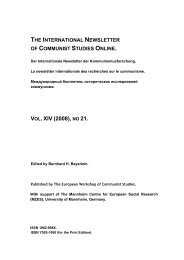11RXNdQ
11RXNdQ
11RXNdQ
Create successful ePaper yourself
Turn your PDF publications into a flip-book with our unique Google optimized e-Paper software.
300).<br />
In Anti-Semite and Jew (1946), Sartre sought to understand the dynamics of the<br />
phenomenon of anti-Semitism. The basic premise of Sartre’s text was taken from Richard<br />
Wright’s observation that ‘There is no Negro problem in the United States, there is only a<br />
white problem’: ‘Contrary to widespread opinion’, Sartre responded, ‘it is not the Jewish<br />
character that provokes anti-Semitism but, rather, … it is the anti-Semite who creates the<br />
Jew’ – Fanon would add that ‘it is the settler who has brought the native into existence<br />
and who perpetuates his existence’ (Sartre 1995:152, 143; Fanon 1965:30). As a result,<br />
Sartre characterized anti-Semitism as ‘a form of Manichaeism’ in which the anti-Semite<br />
splits the people of the world into good and evil: ‘Between these two principles no<br />
reconciliation is conceivable; one of them must triumph and the other be<br />
annihilated’ (Sartre 1995:40–1). He, and subsequently Fanon, then adapted this schema<br />
from the European racialist environment to the colonial situation.<br />
While Sartre focuses on the racism of anti-Semitism, his analysis is applicable, by<br />
inference, to all colonial ideologies supported by racism. The war showed him that life<br />
was not simply a series of existential choices against circumstance: that the domination of<br />
power turns the subject into an object: in this situation, freedom is constituted by taking<br />
responsibility to transform oneself back into an agent. According to Sartre, a refusal to<br />
accept that freedom, which for Sartre defines man, reduces the individual to a state of<br />
inauthenticity. In the situation of anti-Semitism, as Sartre acknowledges, the choice of<br />
freedom and assuming the responsibility of authenticity requires considerable courage.<br />
Where the individual is defined as subhuman on account of racism, one understandable<br />
reaction is to aspire to the group from which he or she is excluded (‘thus the Jew remains<br />
the stranger, the intruder, the unassimilated at the very heart of our society’ (Sartre<br />
1995:83)). For Sartre, however, this would be to live in a situation of inauthenticity: for<br />
the Jew, authenticity ‘is to live to the full his condition as a Jew; inauthenticity is to deny<br />
it or attempt to escape from it’ (Sartre 1995:91). This alternative for the persecuted<br />
subject, to live in a state of authenticity or inauthenticity, was to inspire Fanon in Black<br />
Skin, White Masks (1952). For Fanon, the colonial subject is not only denied his or her<br />
freedom and reduced to an object; he or she is unable to be fully human at an individual<br />
level: colonial oppression works at the level of psychology as well as in material form. If<br />
existence precedes essence, as Sartre argued, then the essence of the colonized subject<br />
aspiring to a ‘white mask’ is one of inauthenticity and bad faith. Sartre’s section in Being<br />
and Nothingness entitled ‘The Look’, one of the most acute analyses he ever wrote, was a<br />
particular inspiration for Fanon – and subsequently for Lacan in his account of the Gaze,<br />
as well as the many discussions of various looks and gazes that followed in European<br />
feminist and film theory. Fanon’s genius was to recognize the implicit gender and class<br />
position in Sartre’s account of how, at a phenomenological level, the individual<br />
experiences the Other as an object. Soon, the looker finds himself looked at in turn and<br />
becomes conscious of himself as an object, or rather of seeing himself seen as an object:<br />
‘I am no longer master of the situation’ (Sartre 1958:263–8). In Sartre’s account of how a<br />
lack of self-worth is mediated by the look of the Other, Fanon recognized an insight into<br />
the mechanics of how colonialism was able to produce a sense of inferiority in colonial<br />
subjects, of the psychopathology by which the colonized individual was led to experience<br />
him or herself at one remove as an object. The look turns the subject into an object: ‘I




